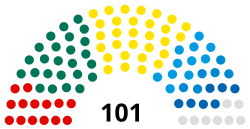Estonian parliament
|
Estonian Parliament Riigikogu |
|
|---|---|
| XIII Riigikogu | |
 |
|
| Type | |
| Type | |
| Leadership | |
|
President of the Riigikogu
|
|
| Structure | |
| Seats | 101 (list) |
 |
|
|
Political groups
|
Government (56) Opposition (45) |
| Elections | |
|
Party-list proportional representation Modified D'Hondt method |
|
|
Last election
|
1 March 2015 |
|
Next election
|
2019 or earlier |
| Meeting place | |
| Toompea Castle, Tallinn | |
| Website | |
| www.riigikogu.ee | |
Government (56)
Opposition (45)
The Riigikogu (Estonian pronunciation: [ˈriːgikogu]; from riigi-, of the state, and kogu, assembly) is the unicameral parliament of Estonia. All important state-related questions pass through the Riigikogu. In addition to approving legislation, the Riigikogu appoints high officials, including the Prime Minister and Chief Justice of the Supreme Court, and elects (either alone or, if necessary, together with representatives of local government within a broader electoral college) the President. The Riigikogu also ratifies significant foreign treaties that impose military and proprietary obligations, bring about changes in law, etc.; approves the budget presented by the government as law and monitors the executive power.
April 23, 1919, the opening session of the Estonian Constituent Assembly is the birthday of the Estonian Parliament. The first elections to the Riigikogu took place in 1920. From 1920 to 1938, there were five more elections to the Riigikogu, but several were on the basis of different constitutions. In 1920–1923 there was a closed list, while from 1926 to 1934 there was an optional open list choice. The basis of election was until 1932 proportional representation. The elections were on a regional basis, without any threshold in the first two elections, but from 1926 a moderate threshold (2%) was used.
From 1938–1940 the National Assembly was divided into two chambers: The Chamber of Deputies (Riigivolikogu) and the National Council (Riiginõukogu).
It was replaced by the Supreme Soviet of the Estonian Soviet Socialist Republic (August 25, 1940–1990) and the Supreme Council of the Republic of Estonia (May 8, 1990 – October 5, 1992).
Since 1922, the sessions of the Riigikogu have taken place in the Toompea castle, where a new building in an unusual Expressionist style was erected in the former courtyard of the medieval castle in 1920–1922. During the subsequent periods of Soviet occupation (1940–41), German occupation (1941–44) and the second Soviet occupation (1944–1991) the Riigikogu was disbanded. The castle and the building of the Riigikogu were used by the Supreme Soviet of the Estonian SSR during the second Soviet occupation.
...
Wikipedia
